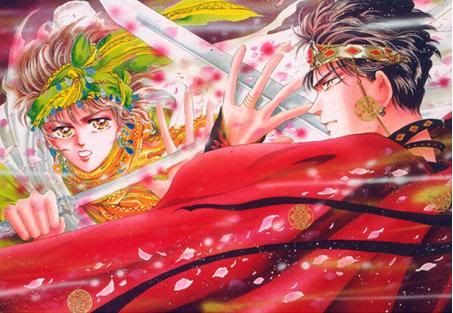
If this manga could be described in one sentence, it would be "heroic fantasy as seen through a feminine lens". The structure of Basara is a familiar one: a hero rises from humble circumstances to change a world that is under the thrall of an evil king. Yet this version is also heavily inundated with romance (by both the classical and modern definition) and melodrama. Many tears are shed on all sides and by both genders, and the central conceit is that the heroine and hero are actually on opposite sides of a war…but they don't realize it when they fall in love.
Technically Basara is science fiction, as it takes place in a post-apocalyptic Japan that has become in large part a desert. But to the initial eye, these characters seem to come from the distant past, with robes and swords and ancient-looking villages. The exact nature of the disaster is never explained, with the present-day story being far more important.
Japan is under the rule of King Ukon, who has divided his territory among his chidren: the Black, White, Red, and Blue Kings. In a small desert village, a pair of boy and girl twins have been born, and one is prophesied to be the "child of destiny" that will save Japan. Everyone assumes it is the boy, Tatara, and he is celebrated while his sister Sarasa grows up in his shadow.
However, when a raid by the Red King's army leads to Tatara's death, Sarasa disguises herself as her brother, and sets out to gather allies, overthrow the dynasty, and bring peace to Japan. Sometimes she goes to bathe undisguised at the nearest hot spring, and there she meets a handsome boy named Shuri. They fall in love, meeting at hotsprings and communicating long distance. However, neither realizes they are Tatara and the Red King, sworn enemies.
Basara is an epic in the truest sense. Unlike some other long manga series, each volume, except for the last two, feels like a single novel split into multiple parts, with the story gathering momentum through each book, and the scope of the world gradually revealed. No space feels wasted, and more importantly, though it is wide in scope with a large cast, Basara remains focused on the emotion and characterization, which makes the larger plot compelling.
Also like most good stories, Basara does not proceed in a straight line to the ending its characters anticipate. Shuri and Sarasa discover the truth in the middle of the story, and King Ukon is not what they would expect when the audience finally meets him.
The girl-disguised-as-a-boy is a classic trope, and thankfully Basara doesn't keep it a secret from her allies until the very end. Sarasa is a compelling heroine, one of those who is obviously destined to win, but shows enough weakness and indecision that they are "human" while still obviously a hero. Sometimes the emotions involved may seem a bit over the top, but that is the nature of this genre of manga. Shuri is also a worthy match, fierce in battle but easygoing out of it, and able to question himself and his role. Both of their characters change and develop over time, and other cast members also change.
And, if you're searching for progressive ideals in fiction, one could do much worse than Basara. It's the sort of story where some concession is made towards a realistic depiction of the status of women in a "medieval" country, but female characters are given plenty of opportunities to shine in both feminine and masculine roles. The story also doesn't suggest that Sarasa secretly pines to return to her "proper" role as a girl. Any moments where she wishes to "just be a girl" are attributed to normal stress, and are about her young age more than her gender.
The art is shojo art, consistent with its manga genre. The young adult characters are often lean and androgynous, with similar bodies once the hair, skin tone, and clothing are taken out of account. However, Tamura can also draw characters of other body types and ages. "Cute" characters such as babies and Sarasa's pet owlet Shinbashi are drawn in a cartoony, scribbled style, which creates an inconsistency. Backgrounds are often amorphous and can make it difficult to see what is going on in the worst cases. However, the costume designs are great, and the art isn't actually bad, it's just a style that may be difficult to get used to, since by 2012, it might be considered "old-school".
The actual story ends at volume 25, while the material continues to volume 27. These last two volumes are a disappointment: Tamura's short comic strips about her characters are fun, but the rest of it, the series of short stories, add things we don't need to see or don't want to see. There are revelations and sequel content that are too cheesy, or too unnecessarily bleak. They can't bring down the rest of the series, but they are disappointing volumes.
Basara is neither a story about the large conflict or the small conflict. Both blend together, both are important, and this gives the series a richer feel than it otherwise would have. It is a crying shame that this series is currently out of print, with volumes 18-20 suffering from enormous price inflations on the secondary market.

No comments:
Post a Comment